Good things
come in small packages...
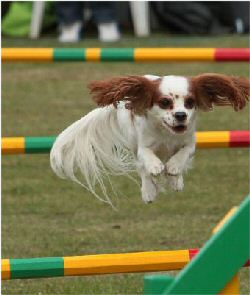 When asked to write this article, Lucy Parkin of Cleverpawz was both shocked - and humbled - to
think that someone thought her words and musings would be worth publishing for all to see. After the initial shock wore off, the panic began to set in. She had never written an article
before and began to wonder if she had enough experience and knowledge to share. Regardless of
her trepidation, she put pen to paper, and this is the result. When asked to write this article, Lucy Parkin of Cleverpawz was both shocked - and humbled - to
think that someone thought her words and musings would be worth publishing for all to see. After the initial shock wore off, the panic began to set in. She had never written an article
before and began to wonder if she had enough experience and knowledge to share. Regardless of
her trepidation, she put pen to paper, and this is the result.
Training small dogs is a real rollercoaster of a ride. They can be delightful, funny,
endearing, incredibly frustrating, stubborn, distracted, very noisy, surprising and amazing -
and all that in a one minute agility run!
Just
like their stature, every emotion in a Small dog is condensed and intensified which is
fantastic if the emotion is a positive one, but can be a nightmare if it is a negative one. Not
only that, but every breed has its own individual traits and nuances.
Some
small breeds are extremely high energy. I am thinking of the terriers that I train who
constantly demand their handlers to issue precise, up-to-the-second commands or face the wrath
of the yap-yap-yap. Other breeds such as the Cavalier King Charles Spaniels seem to have a flip
switch which determines whether it is their ears or nose which is taking priority. Then you
have the Pugs. This delightful breed can be very successful in agility but can have a tendency
to be very stubborn and demand a patient, enthusiastic handler.
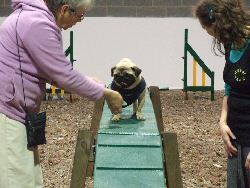 Of
course, these traits are not set in stone, and every individual dog has its very own district
personality, as every dog owner knows. With all that said, I do think that training small dogs
has to have one very important element in common. Of
course, these traits are not set in stone, and every individual dog has its very own district
personality, as every dog owner knows. With all that said, I do think that training small dogs
has to have one very important element in common.
Focus
If you want your dogs to follow your instructions, it is imperative that you first get its
attention as their handler before teaching them any agility equipment. Once you have your dogs
undivided attention, you can train them successfully in agility. I believe the best time to
develop this focus is as a puppy.
Play
is the key here. It must be fun and rewarding as lots of small breeds have attention spans to
match their size, i.e. tiny. Having said that, it is never too late to start playing and
developing focus. I also see lots of rescue dogs who simply don't know how to play, but with
patience and time this can be overcome.
One
of our secret weapons is the squeaky treat bag. It was developed by one of Cleverpawz Pugility
handlers and incorporates a bright furry treat bag with a Velcro fastening. In one end is a
squeaker. The pugs especially love this and follow it intently around the course as they know a
treat of chicken or liver is on its way when they finish.
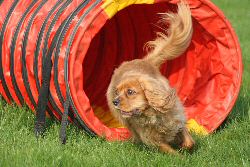 Another tactic we employ is to use a more experienced dog to teach a beginner the basics of the
tunnel. Lots of our beginners were a little wary of going into a tunnel, especially when it was
curved, but send a more experienced dog in first and they are more than happy to follow it
through. A little unconventional, I know, but it works! It also works in reverse if you get a
dog that won't come out of the tunnel - and we have a few - send in another dog to flush them
out. Another tactic we employ is to use a more experienced dog to teach a beginner the basics of the
tunnel. Lots of our beginners were a little wary of going into a tunnel, especially when it was
curved, but send a more experienced dog in first and they are more than happy to follow it
through. A little unconventional, I know, but it works! It also works in reverse if you get a
dog that won't come out of the tunnel - and we have a few - send in another dog to flush them
out.
Reward
The second most important element of training is reward. Lots of small breeds will not work
simply for the joy of working , at least not the way that some of the other breeds will. Of
course, some larger breeds also fall into this category. Think of it this way. How many people
would go to work without getting paid? I think only a few, and those few may be doing it as
volunteers for a better cause. Small dogs don't volunteer! They need to be paid at the correct
rate for their work. High value treats or favourite toys are always a good wage.
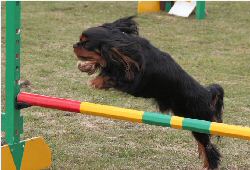 Not
an easy option... Not
an easy option...
After
training and competing with small dogs, I have come to the conclusion that lots of people
simply don't
realise
how much hard work and effort goes in to getting them around an agility course. Small dogs are
totally different to handle and train than larger breeds. They often don't like to work too far
ahead from their handlers until they have gained several years experience in the agility
circuit. Of course, this means for the Small dog handler lots of running!
Small
dogs also seem to be more cautious when it comes to negotiating a course. You can often see
them weighing up the options and deciding how to take a jump or other obstacle. You could say
that they literally look before they leap. This makes it even more important to get your
pre-cuing and shaping commands correct so as to work in tandem with your dog. I do a lot of
training exercises at Cleverpawz which focus on these techniques and it is amazing to see how
well these small dogs respond.
Because
of their size, they have a tighter turning circle which means you can run further up to a jump
without the fear of sending them wide whereas, if you did this with a larger dog, they would
land further away from the jump and turn wider around the wing.
Small
dogs are definitely not the easy option. Some can get de-motivated easily and pick up on the
handler's emotions if they think they have made a mistake. It is very important, in the
training stages, to never let your small dog know if it has gone wrong. Praise and
encouragement is of the utmost importance.
In
conclusion, small dogs can be great fun to train in Agility, but they do require lots of hard
work and effort. They are not the easy option, but when focused can be amazing and amusing. If
you are prepared for lots of bending, coaxing, cajoling, laughing, running and looking silly,
then a small dog is the one for you. If not stick to a proper dog.
Only
kidding!
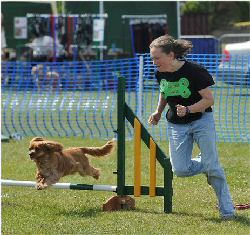 About the author... About the author...
Lucy Parkin is the owner and
trainer at Cleverpawz Dog Activity & Training Centre.
Her previous
dogs were Dylan the Collie and Prince the Cavalier Kling Charles Spaniel, both sadly missed.
Dogs
in the family - all small - include:-
-
Bailey
(Ruby Rascal) - Cavalier King Charles Spaniel (4 years) – Grade 6
-
Chester
(Chestnut
Lightening) - Cavalier King Charles Spaniel (5 years) – Grade 5
-
Jet (Pelynka Jet
Spellcaster) - Cavalier King Charles Spaniel (2 years)– Grade 4
-
Bon Bon
(Clever
Bonnie Belladonna) – Cavalier King Charles Spaniel (2 years)– Grade 4
-
Barack
(Afterglow
Mr President) – American Cocker Spaniel (3 years) – Grade 3
For more details on
anything to do with training small dogs e-mail:- lucy.parkin@doglover.com
or visit
www.cleverpawz.co.uk
First published 17/01/12
|